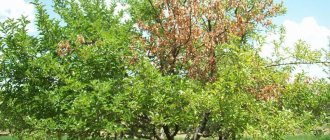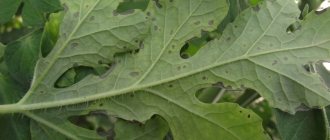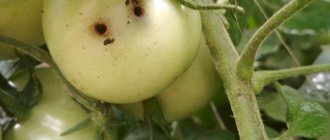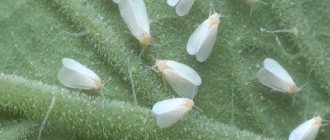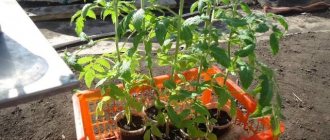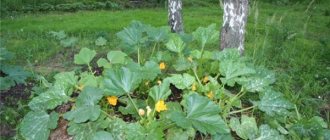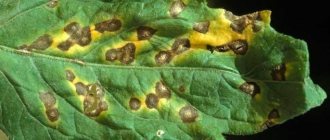Causes
The causative agent of the disease is the phytoplasma microorganism Tomato stolbur phytoplasma. There can be two of them:
- Solanaceae phytoplasma.
- Phytoplasma of aster jaundice.
The shape of the microorganism is spherical or oval. This is a single-celled organism that does not have a cell wall or nucleus, a certain substance. It lives in the plant cell or intercellular space.
According to the type of nutrition, mycoplasmas are classified as biotrophic parasites that live in the conducting system of the plant. As they multiply, they cause changes in the downstream flow of metabolites. Nutrients cannot rise from the root system to the growing young parts of the plant, and the growth process is disrupted and suspended.
Mycoplasmas affect:
- tomatoes;
- potato;
- grape;
- pepper;
- eggplants.
Of the weeds, bindweed, chicory, and spurge are the most commonly affected. The leafhopper may also feast on other plants.
The infection is widespread wherever there are leafhoppers: the southern regions of Russia (the border of distribution is the Samara region), the USA, Israel, Brazil, Australia, India and other countries. The insect can carry the pathogen within itself for up to 3 months. Cicadas prefer:
- uncultivated, virgin lands;
- presence of weeds;
- lack of woody vegetation.
The higher you are above sea level, the lower the likelihood of stolbur; the insect does not want to live there. The peak population of the pathogen occurs in mid-summer and in the second half of August, stolbur manifests itself as symptoms on tomatoes. If the weather is dry and hot, then the intensity of development is very high.
Attention! The infection is not transmitted by seeds. If there are no leafhoppers in your area, stolbur is not possible.
How the disease develops
Phytoplasmosis is caused by pathogens. Nutrients are extracted from living cells. According to the method of nutrition, microorganisms belong to biotrophic ones. They live in cellular and intercellular fluid. Biochemical processes are disrupted and lead to deviations in the growth process. The tissues of the entire plant are affected by the disease, including the fruits and seeds in them.
Photo
Signs of the disease
The accumulation of mycoplasmas in the vascular system blocks the path of nutrients. Young cells suffer from malnutrition, and this is reflected in their appearance:
- the leaf changes shape;
- the value decreases;
- foliage color changes;
- the stem becomes deformed and woody;
- flowers change shape;
- the fruits become dense.
Attention! Tomato stump is very similar to some other diseases: phosphorus deficiency or inability to digest, mosaic, yellow top curl, aspermia.
Foliage
The vegetable grower begins examining the plant from the leaves; they are the first to indicate the disease:
- leaf blades decrease in size;
- the color becomes pale, then chlorotic, heterogeneous, marbled;
- As the disease progresses, pink and purple shades join the green color.
Young foliage is especially striking. The delicate opening leaf becomes small and corrugated, turns pale and ceases to look like a leaf.
Stems
The most characteristic feature is lignification of fruits and stems. As soon as the pathogen penetrates the plant, the process of formation of thick bast and wood rings begins. Stem:
- changes color;
- compacts;
- is bent.
Root system
When examining the roots of a tomato plant, cracks are visible. The bark is turning brown. When cut, you can feel that the internal tissues have become lignified.
Inflorescences
Often the petals of the corolla of flowers enlarge, they grow together, change, and are reduced. The edges of the petals lose shape and color, they acquire purple shades. The internal parts of the flower also undergo changes:
- petals become discolored;
- stamens stop growing and developing;
- pistils become short.
Fruit
The tomato disease Stolbur kills the plant itself and destroys the entire crop. Fruit:
- deformed;
- become dense and hard;
- when cut, the white vascular tissue is clearly visible, it is porous and overgrown in the tissue;
- very few seeds are produced.
Fruits, as a rule, can be completely normal from the outside. However, when cut, it becomes clear that they are not edible. Hard, dense fabrics are difficult to cut. However, they will not necessarily be dry; sometimes the body of the tomato produces a sufficient amount of liquid, which is not much like tomato juice.
The fruit does not give off a special smell, and the plant itself smells like tomatoes when kneading the leaf.
Stolbur or phytoplasmosis of vegetable crops
The affected leaves become smaller, and the plants themselves, infected at an early stage of development, are severely stunted in growth. The flowers have petals that grow together, giving them the shape of a bell. The corolla practically does not develop, the petals become discolored or turn green.
In tomatoes, stolbur affects leaves, flowers and fruits
Pay attention to the photo below:
With stolbur, the color of the apical leaves of tomatoes changes - they become light. The same thing happens with other vegetable crops, and after some time the leaves and stems acquire a purple tint due to the accumulation of anthocyanin in the tissues.
Stolbur of tomatoes and measures to combat the disease
If stolbur affects tomato fruits, they do not acquire normal color during the ripening period. Some of the fruit tissue becomes coarser, so the fruit becomes tough and tasteless. Yellow or white stripes may be seen on the surface of the fruit, representing lignified tissue. The seed chamber grows, the seeds remain underdeveloped or absent altogether.
When tomatoes are infected early, stolbur leads to almost complete sterility. With later infection, up to 70% of the fruits remain edible, but the next harvest from diseased plants is completely inedible.
The main measure to combat tomato stubble is the destruction of weeds. During the summer of leafhoppers, plantings and sowings of vegetable nightshade crops should be sprayed twice with a 0.2% solution of karbofos. To prepare the mixture, 20 g of solution should be dissolved in 10 liters of water.
Tomato stoluur: sources and vectors
The main sources of tomato stolbur are perennial weeds, in the roots of which the infectious agent overwinters. Such weeds include: watercress, field bindweed, thistle, sow thistle, plantain.
The carriers of stolbur are stink bugs and leafhoppers - their larvae live on the roots of vegetable crops and weeds and, feeding on the juices of diseased plants, become infected with mycoplasma. After settling, adult insects carry the infection. The mass gathering of leafhoppers occurs in the second decade of June and lasts on average 15-20 days. The disease appears in the plant 30-40 days after infection.
A hot climate and high humidity accelerate the appearance of stolbur; cold weather, on the contrary, slows down the development of infection.
Potato pillar and measures to combat the disease
Potato stolbur exhibits deformation of the apical leaves. The new leaves formed curl into a tube. The stems and leaves of the potato wither, the tubers grow small, and during germination they form many thin shoots that die. Thus, a significant part of the harvest is lost.
As in the case of tomatoes, to prevent the appearance of stolbur, potatoes must be carefully weeded. Spraying with a solution of karbofos (at the rate of 20 g per 10 liters of water) helps well.
Column of peppers and eggplants
In pepper, stolbur manifests itself as yellowing of the leaves. After a few days, they begin to fold into a boat along the central vein. New leaves on the affected plant grow small and weak. Severe damage leads to the death of the plant. Fruits removed from a diseased specimen look unripe and have a beak-like shape.
The eggplant pillar comes in 2 forms: yellow and green. In the first case, the leaves become smaller, deformed, crumble very quickly, leaving only the topmost leaves, folded into a boat. This leads to rapid withering of the plant. The fruits from such plants are small, hard, and a brown tissue forms inside them. The green form of stolbur appears in the second half of summer. The leaves of the plants practically do not differ in color from healthy ones, but are slightly deformed. The flowers of diseased plants turn into ugly leaf-like formations, and fruits are not formed.
How it spreads
Cicadas are sucking insects. Touching the tender leaf with their proboscis, they try to drink the tissue fluids. At this time, already being a carrier of phytoplasmas, they, even reluctantly, leave the pathogen in the wound surface of the tomato. Next, microorganisms with a current of juice penetrate into the vascular system of the plant and begin to multiply. The rate of growth of the substance is affected by:
- ambient temperature;
- humidity;
- virulence of the pathogen.
Another, conditionally “clean” leafhopper, again touches the already infected plant and absorbs the pathogen with the tissue fluid.
Phytoplasma can live in the body of a leafhopper for 2.5-3 months, and all this time the insect spreads the parasite throughout the tomato bushes.
An infected perennial weed goes into winter and stores phytoplasma in its root system. But dried plant residues, tomatoes and annual herbs do not retain the living pathogen. In the spring, awakening from the currents of cellular juices, mycoplasma rises. Cicadas become infected again by feeding on the tissue sap of a plant containing the pathogen.
Attention! Dried and annual plants do not pose a danger and are not carriers of tomato stolbur.
Where does tomato disease come from?
The main carriers of the disease are leafhoppers of the genus Hyalesthe, pennies and psyllids. Feeding on the sap of infected plants, insects fly around the area and spread the disease. Scientists have found that phytoplasma actively reproduces in the intestines of these insects, and penetrates into new plants with saliva during feeding.
The bindweed leafhopper looks like a small fly, with a body size of 4.5-5.5 mm, translucent elytra of a smoky milky color, a grayish-green forehead and pronotum. Forms one generation per year. The female lays eggs in the soil near the roots starting in mid-June. A month later, larvae appear, feed on the sap of roots and underground stems and go to wintering grounds in the nymph stage. In May they fledge in the soil and fly out. Depending on weather conditions, leafhoppers migrate to nightshade crops from early May to mid-July.
Treatment methods
Treatment for the disease has not been developed. All efforts of farmers are aimed at normalizing the number of leafhoppers. Since stolbur is a natural focal disease, it should be fought in a specific focus.
It has been established that 30 days pass from the moment the plant is infected until the symptoms appear. It should be understood that this is a very arbitrary figure.
As a rule, spreading in one area, it slowly moves to the sides.
Agrarian scientists and vegetable growers are trying in every possible way to break the chain of infection. Sometimes they succeed.
When fighting stolbur, several points should be taken into account:
- It is necessary to reduce the number of insect vectors. Contact agents will not help with this; you need systemic ones, which remain in the foliage for a long time and slowly poison the insect.
- Perennial weeds, which allow the pathogen to overwinter and maintain its virulence, should be removed as best as possible from the garden and surrounding areas.
- Every effort must be made to scare away the insect from the tomato plantation and prevent it from feeding on the plant’s juices.
Attention! In the fight against the disease, all means are good. Don't stop at one. Act comprehensively.
Agrotechnical methods of control
Agricultural technology in the fight against stolbur is based on the constant and regular destruction of weeds on which leafhoppers feed. The smaller the food supply for an insect, the smaller its population in a certain area.
Pre-winter plowing of the garden and spring cultivation will help eradicate perennial weeds.
If the garden is near a desert area, every effort must be made to prevent it from becoming overgrown with weeds. To do this, you can use plowing or treat the area with long-acting herbicides.
Folk remedies
Effective folk methods include onion and garlic. Experienced vegetable growers have long noticed that leafhopper insects absolutely cannot stand the smell of garlic. By planting the garden around the perimeter, as well as along the tomato beds, you can repel insects.
Garlic infusion also helps. Since most raids occur in June-July, by this time there are already garlic shoots. Do this:
- garlic arrows or garlic greens, chopped;
- pour water at the rate of 100 g per bucket of water;
- insist for a day;
- strain;
- sprayed.
More experienced vegetable growers go even further. They pour the remains from preparing the infusion into containers along with the thick fraction and place the containers along the tomato bed. The smell that garlic gives off repels the insect so much that the leafhopper does not approach the tomatoes.
Chemicals for soil and plant treatment
No matter how gardeners intend to treat the soil with chemicals, this is not necessary. It is not possible to get the pathogen.
There is also no point in using contact agents; they only work when they come into contact with an insect. Of course, if there are so many leafhoppers that they have filled the entire area, then contact means must be used in the battle.
Phytoplasmin
A biological pesticide based on the macrolide tylosin complex. The antibiotic substance works on the basis of the soil actinomycete Streptomyces fradiae, strain VNI ISKHM-53. The drug has a systemic effect and is recommended for use both in open and buried ground.
The drug has:
- prolonged action. Protection lasts 3-4 weeks;
- the ability to use in tank mixtures;
- low toxicity to beneficial insects;
- 3rd class of danger.
Spraying is carried out a month after planting the seedlings with simultaneous watering at the root. The treatment interval is 15-20 days.
Phytoplasmin allows tomatoes to form ovaries and ripen even where the flight intensity of the insect vector is high.
Confidor
Systemic insecticide based on imidacloprid. Has a prolonged action. Accumulating in the leaves, it stays for a long time. The insect, when sucking tissue juices, swallows the active substance and dies within 3-5 days. The period of protective action is 15-20 days.
Dark sunken spots on tomato fruits
The fruits are covered with softened spots up to 1 cm in diameter. At first they are hardly noticeable and do not differ from the color of the skin. Then they darken and turn black. The fruits are completely mummified. Brown flaky spots are visible on the roots.
Diagnosis: tomato anthracnose is a fungal disease.
Anthracnose is widely found both in open ground and in greenhouses. More often, mature bushes suffer from it. The peak of the disease occurs in late summer and early autumn. Mainly fruits, roots and root collars are affected. Ripe tomatoes cannot be eaten; they are watery and tasteless. The spots darken over time, and fungal spores become visible on them. Anthracnose often appears on bushes together with Alternaria, causing a mixed infection.
Control measures. Remove the affected fruits and spray the bushes with copper oxychloride (40 g per bucket of water) or 1% Bordeaux mixture. The latter can also be used to prevent disease. To do this, spray the plantings 3-4 times every 10-12 days. When the greenhouse is empty, completely disinfect it with bleach (200 g per 10 liters of water).
Prevention measures
If tomato stolbur is diagnosed, control measures are reduced not only to the use of phytoplasmin, but also to preventive actions.
To protect the tomato bed from stolbur, you can apply the following measures:
- select early ripening tomato varieties;
- give preference to varieties resistant to stolbur;
- carry out, if possible, early planting of seedlings at least 65 days old;
- maintain spatial isolation between nightshade crops of at least 300 m;
- constantly destroy perennial weeds along tomato beds;
- normalize the leafhopper population by applying systemic insecticides to nightshade crops.
Many vegetable growers are interested in the issue of replacing the soil in the greenhouse when a stolbur appears. This measure is not effective. A living substance needs a living cell: the body of an insect or a plant cell. The soil of a garden or greenhouse, if perennial weeds do not grow on it, cannot contain the pathogen.
Folk remedies
Unfortunately, folk remedies cannot cure stolbur. You can only try to protect tomatoes from the invasion of harmful insects that carry diseases. For this purpose, tall crops (corn, sunflower, amaranth, Jerusalem artichoke) are planted around the beds with tomatoes in the form of wings. This technique will prevent flying pests from landing on the bushes.
You can keep plants untouched by insects by installing arches with lutrasil stretched over them.
Spraying tomatoes will help scare away leafhoppers from tomatoes:
- infusion of garlic (1 glass of crushed cloves per bucket of water);
- a solution of tar, brown laundry or green soap (100 g per 10 liters of water);
- tobacco infusion (a glass of shag in a bucket of water).
You can spray your plantings frequently with these products; this will not cause any harm to the plants or the future harvest. Be sure to irrigate tomatoes after rain to restore the smell of the product.
Disease-resistant varieties
Vegetable growers have identified several varieties resistant to stolbur:
- Premium;
- Elizabeth;
- Volgogradsky;
- Sovereign;
- Legionary;
- East;
- Standard Alpatiev.
However, it should be taken into account that when registering the varieties, the commission did not give any of them the mark “Resistant to tomato stubble.” Today there are no such varieties. Strict measures for prevention and control of insects are needed.
You can deceive insects and nature by planting very early varieties. In this case, before the insects fly, the tomato has time to bloom and form an ovary. The fruit begins to grow. The incubation period is 30 days. Consequently, the first tomatoes, even from an already infected plant, have time to grow and ripen. If we add preventive measures to this, then it is possible to get a good harvest of tomatoes even with a high degree of insect presence.
Diseases initiated by viruses
The causative agents are viruses, hundreds of times smaller than bacteria. There are no drugs against viral diseases of tomatoes, so the infected plant must be isolated and destroyed. The carriers are both parts of infected plants and insect pests.
Much attention should be paid to prevention, which includes a whole range of measures to combat tomato diseases:
- soil treatment before planting: disinfection, calcination;
- preparation of seed material, preliminary disinfection;
- isolation of diseased plants;
- compliance with planting rules: distance between bushes, water and light conditions;
- compatibility with other crops, do not plant tomatoes next to plants that are potential carriers of viruses, remove weeds;
- pest control.
Aspermia
Another name is seedlessness. The virus infects the generative parts of the plant. The flowers grow together, become deformed, and the seeds do not ripen in the fruits. The photo of tomatoes suffering from aspermia shows that the leaves of the plant become small, the stem is weak, and the flower stalks do not develop.
Pathogen: Tomato aspermy cucumovirus.
The aspermia virus enters tomatoes from insects or other plants (for example, from chrysanthemums)
Preventative measures include:
- isolation and destruction of diseased plants in greenhouses;
- control of aphids;
- weed control;
- separate tomatoes and chrysanthemums geographically.
Bronzing
A sign of infection with the leaf bronzing virus is the appearance of a characteristic pattern on the fruits and leaves in the form of brownish rings. The main carriers are thrips. The virus dies at temperatures above 45 degrees.
Pathogen: Tomato spotted wilt virus.
Prevention: calcination of the soil before planting seeds, destruction of thrips.
Yellow curl
Tomato curl virus infects leaves, which become small, deformed, and unevenly colored. The bush does not grow in height, the fruits do not set.
Pathogen: Tomato yellow leaf curl virus.
Prevention: The virus is most often transmitted by whiteflies. Therefore, preventive measures are aimed at preventing the proliferation of these insects.
Top bushiness
The manifestation of the disease is first noticed on the leaves. White dots appear on them, which then darken. The leaf blades become rough, the veins turn blue, and the leaf itself curls at an acute angle. The bush takes on the shape of a spindle.
Pathogen: Tomato bunchy top viroid.
Prevention: Aphids and infected seeds become carriers of the virus. The virus is inactivated at a temperature of 75 degrees. Preventive measures include cultivating the soil before planting and destroying aphid colonies.
Mosaic
Infection occurs from infected seeds. Most often found in plants grown in open ground. The leaves are covered with light and dark spots, like a mosaic, and the fruits have yellow spots.
Pathogen: Tomato mosaic tobamovirus.
Prevention:
- Treatment of seeds before planting.
- The diseased plant is removed.
- Dead bushes are burned.
- Among folk remedies, it is suggested to treat young bushes 3 times a month with milk and urea.
Stolbur (phytoplasmosis)
Infection appears on leaves, stems, flowers and fruits. The leaves change color, first turning pink, then darkening, becoming rough and brittle. The edges curl up and the leaf becomes like a boat. The flowers grow together, lengthen, the petals remain small. Usually, fruits do not form from them, or small tomatoes appear, with uneven coloring, white and hard from the inside. They cannot be eaten.
Pathogen: Lycopersicum virus 5 Smith virus.
Prevention: disinfection of planting material and soil, isolation of tomatoes from other vegetable crops, control of insect vectors.
Column of tomatoes photo
Looking at the stolbur on tomatoes, the photos clearly show exactly what the leaves, shoots and fruits look like during the initial stages of the disease and at the height of the disease.
Unfortunately, it is difficult to make a diagnosis from a photo. Sometimes viral diseases are very similar to stolbur, which does not make them any more attractive.
If your tomatoes are similar to those shown in the photo, sound the alarm. However, analyze it well:
- region of cultivation;
- the presence of an insect vector;
- talk to your vegetable grower neighbors to see if they have this problem in their tomato garden.
If the neighboring city is clean, then the likelihood of stolbur disappears. Cicadas will ruin crops over long distances.
Interesting video
Unfortunately, the video does not always show the essence of the problem. It should be understood that amateur videos are filmed by amateurs who have not encountered the problem and provide only theoretical information.
Comments under videos and reviews are a completely different matter. Gardeners are trying in every possible way to share their experience in the field of growing tomatoes in their geographical area. From such reviews you can glean information about the spread of the disease and effective methods of prevention and treatment.
